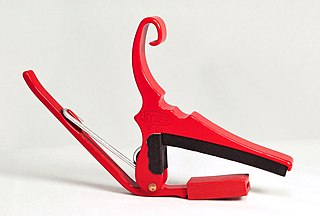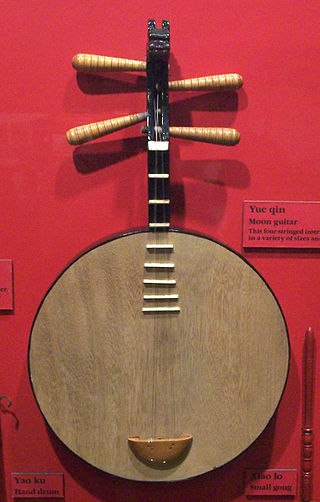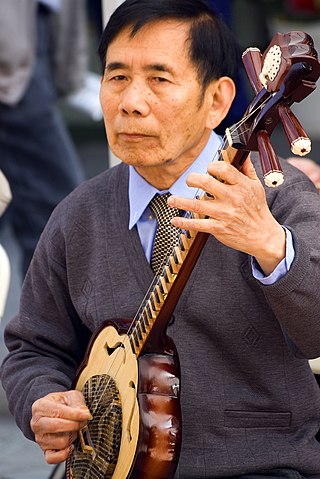
The guitar is a stringed musical instrument, that is usually fretted and typically has six or twelve strings. It is usually held flat against the player's body and played by strumming or plucking the strings with the dominant hand, while simultaneously pressing selected strings against frets with the fingers of the opposite hand. A guitar pick may also be used to strike the strings. The sound of the guitar is projected either acoustically, by means of a resonant hollow chamber on the guitar, or amplified by an electronic pickup and an amplifier.

In musical instrument classification, string instruments or chordophones, are musical instruments that produce sound from vibrating strings when a performer plays or sounds the strings in some manner.

A fret is any of the thin strips of material, usually metal wire, inserted laterally at specific positions along the neck or fretboard of a stringed instrument. Frets usually extend across the full width of the neck. On some historical instruments and non-European instruments, frets are made of pieces of string tied around the neck.

A capo is a device a musician uses on the neck of a stringed instrument to transpose and shorten the playable length of the strings—hence raising the pitch. It is a common tool for players of guitars, mandolins, mandolas, banjos, ukuleles and bouzoukis. The word derives from the Italian capotasto, which means the nut of a stringed instrument. The earliest known use of capotasto is by Giovanni Battista Doni who, in his Annotazioni of 1640, uses it to describe the nut of a viola da gamba. The first patented capo was designed by James Ashborn of Wolcottville, Connecticut year 1850.

The bouzouki is a musical instrument popular in Greece. It is a member of the long-necked lute family, with a round body with a flat top and a long neck with a fretted fingerboard. It has steel strings and is played with a plectrum producing a sharp metallic sound, reminiscent of a mandolin but pitched lower. There are two main types of bouzouki: the trichordo (three-course) has three pairs of strings and the tetrachordo (four-course) has four pairs of strings. The instrument was brought to Greece in the early 1900s by Greek refugees from Anatolia, and quickly became the central instrument to the rebetiko genre and its music branches. It is now an important element of modern Laïko pop Greek music.

Tōru Takemitsu was a Japanese composer and writer on aesthetics and music theory. Largely self-taught, Takemitsu was admired for the subtle manipulation of instrumental and orchestral timbre. He is known for combining elements of oriental and occidental philosophy and for fusing sound with silence and tradition with innovation.

The shamisen, also known as sangen or samisen (all meaning "three strings"), is a three-stringed traditional Japanese musical instrument derived from the Chinese instrument sanxian. It is played with a plectrum called a bachi.
The fingerboard is an important component of most stringed instruments. It is a thin, long strip of material, usually wood, that is laminated to the front of the neck of an instrument. The strings run over the fingerboard, between the nut and bridge. To play the instrument, a musician presses strings down to the fingerboard to change the vibrating length, changing the pitch. This is called stopping the strings. Depending on the instrument and the style of music, the musician may pluck, strum or bow one or more strings with the hand that is not fretting the notes. On some instruments, notes can be sounded by the fretting hand alone, such as with hammer ons, an electric guitar technique.

The biwa is a Japanese short-necked wooden lute traditionally used in narrative storytelling. The biwa is a plucked string instrument that first gained popularity in China before spreading throughout East Asia, eventually reaching Japan sometime during the Nara period (710–794). Typically 60 centimetres (24 in) to 106 centimetres (42 in) in length, the instrument is constructed of a water drop-shaped body with a short neck, typically with four strings. In Japan, the biwa is generally played with a bachi instead of the fingers, and is often used to play gagaku. One of the biwa's most famous uses is for reciting The Tale of theHeike, a war chronicle from the Kamakura period (1185–1333). In previous centuries, the predominant biwa musicians would have been blind monks, who used the biwa as musical accompaniment when reading scriptural texts.

A multi-scale fingerboard is an instrument fretboard which incorporates multiple scale lengths. This allows each of the strings to have a different string tension and thus, balanced tonal characteristics.

The yueqin, also called a moon lute or moon guitar, is a traditional Chinese string instrument. It is a lute with a round, hollow soundboard, a short fretted neck, and usually four strings. It is an important instrument in the Peking opera orchestra, often taking the role of main melodic instrument in lieu of the bowed string section.

The qinqin is a plucked Chinese lute. It was originally manufactured with a wooden body, a slender fretted neck, and three strings. Its body can be round, hexagonal, or octagonal. Often, only two strings were used, as in certain regional silk-and-bamboo ensembles. In its hexagonal form, it is also referred to as meihuaqin.
The truss rod is a component of a guitar or other stringed instrument that stabilizes the lengthwise forward curvature of the neck. Usually, it is a steel bar or rod that runs through the inside of the neck, beneath the fingerboard. Some are non-adjustable, but most modern truss rods have a nut at one or both ends that adjusts its tension. The first truss rod patent was applied for by Thaddeus McHugh, an employee of the Gibson company in 1921, though the idea of a "truss rod" appears in patents as early as 1908.
In music, intonation is the pitch accuracy of a musician or musical instrument. Intonation may be flat, sharp, or both, successively or simultaneously.

In Indian classical music, javārī refers to the overtone-rich "buzzing" sound characteristic of classical Indian string instruments such as the tanpura, sitar, surbahar, rudra veena and Sarasvati veena. Javari can refer to the acoustic phenomenon itself, or to the meticulously carved bone, ivory or wooden bridges that support the strings on the sounding board and produce this particular effect. A similar sort of bridge is used on traditional Ethiopian lyres, as well as on the ancient Greek kithara, and the "bray pins" of some early European harps operated on the same principle. A similar sound effect, called sawari, is used on some traditional Japanese instruments as well.

A zero fret is a fret placed at the headstock end of the neck of a banjo, guitar, mandolin, or bass guitar. It serves one of the functions of a nut: holding the strings the correct distance above the other frets on the instrument's fretboard. A separate nut is still required to establish the correct string spacing when a zero fret is used.

The 3rd bridge is an extended playing technique used on the electric guitar and other string instruments that allows a musician to produce distinctive timbres and overtones that are unavailable on a conventional string instrument with two bridges. The timbre created with this technique is close to that of gamelan instruments like the bonang and similar Indonesian types of pitched gongs.
A third bridge can be devised by inserting a rigid preparation object between the strings and the body or neck of the instrument, effectively dividing the string into distinct vibrating segments.
November Steps is a musical composition by the Japanese composer Tōru Takemitsu, for the traditional Japanese musical instruments, shakuhachi and biwa, and western orchestra. The work was commissioned by the New York Philharmonic on the occasion of its 125th anniversary, and premiered in November 1967 by the orchestra under the direction of Seiji Ozawa.

The heike shamisen, is a Japanese musical instrument, member of the shamisen family. Like its other counterparts, the heike shamisen has three strings, a slender neck, a body taut with skin, and it is plucked with a plectrum called a bachi.
Eclipse is a composition for shakuhachi and biwa by Japanese composer Tōru Takemitsu. It was composed in 1966.














